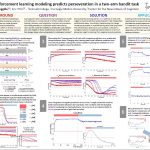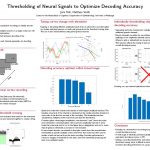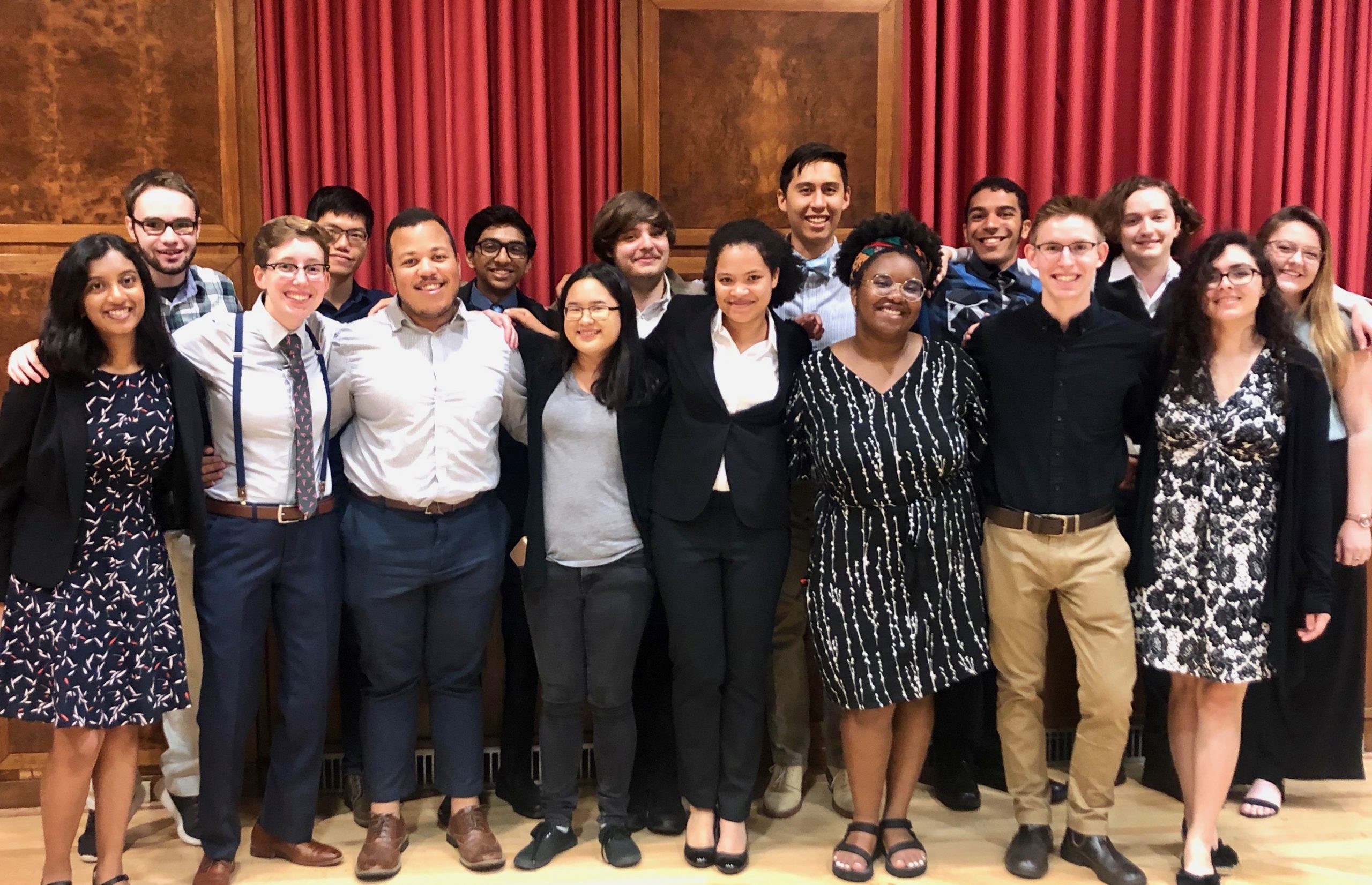L-R: Anisha Babu, Jason Biundo, Taylor Kveragas, Ho Yin Chau, Bryan Medina, Vijeeth Guggilla, Susan Cheng, Max Kramer, Deja Machen, Roy Phillips, Arnelle Etienne, Joseph Nelson, Jack Burgess, Jack Toth, Rekha Crawford, Kendra Noneman.
Below is the 2019 Summer Undergraduate Research Program in Neuro Computation (uPNC) class roster. Selecting the name of the student will take you to a short description the the student’s research and link to their poster.
The 2019 Summer Schedule can be downloaded here (pdf format).
Anisha Babu
 Undergraduate Institution: Ohio State University
Undergraduate Institution: Ohio State University
Mentor: Steve Chase
University and Department: Carnegie Mellon University, Biomedical Engineering
Project Description: It is well known that neurons in primary motor cortex change their tuning to movement when arm workspace changes. Changes in workspace could potentially be driven by two sensory inputs: vision, and proprioception. To dissociate which of these might have a larger influence on cortical changes in tuning, Anisha Babu analyzed monkey neural recordings data from a sensory dissociation task in which the cursor could be visually displaced from hand location in a virtual reality environment. Anisha constructed naive Bayes classifiers to quantify the impact of postural vs visual changes in workspace and found that neural tuning change is driven by postural, not visual changes. These results have implications for transfer learning, in which learning in one workspace needs to be applied to another.
back
Jason Biundo
 Undergraduate Institution: University of Massachusetts, Amherst
Undergraduate Institution: University of Massachusetts, Amherst
Mentor: Aryn Gittis
University and Department: Carnegie Mellon University, Biological Sciences
Project Description: Jason Biundo studied the physiology of basal ganglia output. His project piloted the use of high density recording arrays to record from dozens of neurons across the medial-lateral extent of the substantia nigra pars reticulata, the major basal ganglia output nucleus in rodents. Jason found a gradient of electrophysiological properties in the nucleus that correlated with the gradient in expression of genetic markers, suggesting a hierarchical distribution of neuronal subpopulations in the nucleus.
back
Jack Burgess
 Undergraduate Institution: Dartmouth College
Undergraduate Institution: Dartmouth College
Mentor: Tim Verstynen
University and Department: Carnegie Mellon University, Psychology
Project Description: The exploration-exploitation dilemma is a fundamental but intractable problem in the learning and decision sciences. This problem concerns whether an animal (or any reinforcement learning agent) should follow actions it knows leads to reward (“exploitation”) or explore actions of unknown reward value (“exploration”). The problem is intractable as currently formulated with the objective of maximizing reward. However, recent theoretical work at CMU has found that if the problem is restated so there are separate values for reward and information, there is an easy solution (Peterson & Verstynen, 2019).
As part of the uPNC summer research program Jack Burgess conducted the first experimental test of this theory in human subjects. To do so, he helped design and implement a novel behavioral task that examined whether humans maintain separate values for reward and information. Jack played a critical and creative role in analyzing the data he collected (n=24 subjects). The preliminary results were strongly consistent with the theoretical predictions. His work this summer was an important first step in testing the validity of a new solution to a classic, and supposedly intractable, problem.
Ho Yin Chau
 Undergraduate Institution: University of California, Berkeley
Undergraduate Institution: University of California, Berkeley
Mentor: Tai Sing Lee
University and Department: Carnegie Mellon University, Computer Science
Project Description: Ho-Yin Chau investigated how a neural circuit for Bayesian causal inference can be learned in the context of multisensory cue integration. In areas MSTD and VIP of primate multi-sensory cortex, it has been found that some neurons exhibit invariant head direction tuning regardless of sensory modalities, i.e., each of these congruent cells is tuned to a specific heading direction of the animal irrespective whether the head direction cue is coming from the visual system or the vestibular system. However, there is a peculiar type of cells, of equal prevalence, that are tuned to one direction for one cue, and yet tuned to the opposite direction (180 degrees rotation) for the other cue. These are called the opposite cells. It has been proposed that these opposite cells might play a role in solving the so-called Bayesian causal inference or model selection problem. When making inference about heading direction based on cues coming from different sensory modalities, the brain has to decide whether these cues should be combined or kept segregated during inference. The former case applies when the animal is actually moving in an environment. What its visual system sees and what its vestibular system senses are consistent. Hence the visual and the vestibular cues should be combined to make a coherent inference of the heading direction. The latter case applies when the animal is sitting on a stationary chair but seeing itself moving in the environment based on visual cues in a virtual reality device. The two cues are now derived from incongruent sources, and should not be combined to make a unitary head direction inference. The act of deciding whether head direction inference should be made under the integration assumption or the segregation assumption is called causal inference. Mathematical theories and neural circuit models have been developed, demonstrating that the behaviors of opposite cells are consistent with the computation and representation of the Bayes factor in causal inference. An important unanswered question is how the neural representation of congruent neurons and opposite neurons can be learned using plausible neural circuits and mechanisms. Ho-Yin developed and implemented a model based on Hebbian learning and anti-Hebbian learning mechanisms as a potential solution to this problem. This problem is fundamental as it is pertinent to understanding the development of the general neural mechanisms for causal inference. Thus, his proposed solution to this problem is a meaningful scientific contribution that should be publishable in a respectable journal.
Susan Cheng
 Undergraduate Institution: Carnegie Mellon University
Undergraduate Institution: Carnegie Mellon University
Mentor: Bard Ermentrout
University and Department: University of Pittsburgh, Mathematics
Project Description: The auditory click paradigm involves subjects listening to clicks at different frequencies while at the same time recording EEG responses from the auditory areas. It has been found that normal (No) subjects have a peak response at about 40 Hz while subjects that have schizophrenia (Sz) have a peak response at a lower frequency. It has been hypothesized that the inhibitory PSP decay time is slower in Sz than in No. Susan Cheng and her mentors built a network of inhibitory and excitatory spiking neurons using the theta model and studied the response to click stimuli. We also made a reduced firing rate model by applying the Ott-Antonsen ansatz to a heterogeneous network of theta neurons. Using a combination of simulation and numerical continuation we were able to show that the peak response is at about 40 Hz for No and the resonant frequency decreases with increases in the inhibitory decay.
Rekha Crawford
 Undergraduate Institution: Swarthmore College
Undergraduate Institution: Swarthmore College
Mentor: Rob Gaunt
University and Department: University of Pittsburgh, Physical Medicine and Rehabilitation
Project Description: After a cervical spinal cord injury (SCI), people frequently have limited or no ability to move their arms and hands. Improving arm and hand function is a major goal for these people because it is so important in many activities of daily living. One method to tackle this problem is to create neural interfaces between the brain and robots so that areas of the cortex normally involved in controlling and sensing the upper limb can be linked to a prosthesis. We are working with human subjects with SCI that have multi electrode arrays implanted into the motor and somatosensory regions of the brain and that allow them to both control a robotic prosthesis to reach out and grasp objects, as well as feel those objects in their own hand when the robot grasps them. These sensations are generated using electrical stimulation pulses in the cortex, and one question that arrises is what effect this stimulation has on recruiting neural circuits in the motor cortex. Rekha Crawford took an existing data set where stimulation was being delivered to the brain and examined the neural recordings in the motor cortex to see whether we could detect evidence of changes in activity during stimulation. In the averaged data across all recording electrodes, there was very little evidence of changes in neural activity. However, individual electrodes did show some changes in activity that evolved during the stimulation pulse trains with some neurons increasing their firing rate and other decreasing their firing rate. After using factor analysis to reduce the activity in the motor cortex to a low-dimensional dataset, Rekha used linear discriminant analysis to see if whether the changes in motor cortex activity reflect stimulation state. She found that across many different stimulation channels and parameters, she could tell whether stimulation was occurring or not about 70% of the time, with the peak in prediction performance occurring about 700 ms after the start of a pulse train. This suggests that stimulation does in fact recruit natural sensorimotor pathways.
Arnelle Etienne
 Undergraduate Institution: Carnegie Mellon University
Undergraduate Institution: Carnegie Mellon University
Mentor: Pulkit Grover
University and Department: Carnegie Mellon University, Electrical and Computer Engineering
Project Description: : Existing EEG systems do not work consistently across individuals with different hair types. Arnelle Etienne advanced on ideas on EEG for all hair types, a project she has led from its inception. She is a key member of the team that fabricated new clips for securing EEG electrodes to the scalp that work particularly well with braided and unbraided hair. The project addresses a clinical need that many people with coarse, curly, thick, and/or long hair have: that existing EEG systems do not work for their hair.
Vijeeth Guggilla
 Undergraduate Institution: Grinnell College
Undergraduate Institution: Grinnell College
Mentor: Eric Yttri
University and Department: Carnegie Mellon University, Biological Sciences
Project Description: Reversal learning is a crucial method of adapting to one’s environment and is often studied by using two-arm bandit tasks. These tasks can model dynamic environments by shifting reward probabilities. Performance in these tasks relies on striatal direct and indirect pathway activity, which contributes to action selection and reinforcement.
Dual opponent actor reinforcement learning can be used to model such pathways in a novel manner to further explore reversal learning. However, over long blocks in dynamic environments, the model generates an inexplicable performance decay. How can this model be modified to ameliorate such artifacts, and what insight do these modifications provide? What do the changes imply when extrapolated to a biological context?
Discounting the learning rate for direct pathway in trials with negative reward predictions erases long-term task independent performance decay. Accordingly, Vijeeth Guggilla worked with his mentors to implement the change to reveal perseveration in reversal learning tasks with long blocks. Additionally, the team used a Y-maze task with mice to generate preliminary data in a reversal learning task with long blocks. Dopamine dependency of this task was studied via direct and indirect pathway inhibitors. The perseveration observed in such contexts is relevant to biological systems in explaining fixation behavior in terms of giving less weight to learning from negative reward prediction.
Max Kramer
 Undergraduate Institution: Oberlin College
Undergraduate Institution: Oberlin College
Mentor: Mike Tarr
University and Department: Carnegie Mellon University, Psychology
Project Description: Max Kramer explored the representation and role of color information in face processing and recognition using a convolutional neural network. He demonstrated that an artificial face processing model exhibited a pattern of performance degradation for grayscale blurred faces similar to that seen for humans (absent for color faces). However, CNNs are sufficiently robust to facial shape differences across sex that color differences in male and female faces are not used by the model – despite the fact that humans appear to learn such color differences.
Taylor Kveragas
 Undergraduate Institution: University of Pittsburgh
Undergraduate Institution: University of Pittsburgh
Mentor: Nathan Urban
University and Department: University of Pittsburgh, Neurobiology
back
Deja Machen
 Undergraduate Institution: University of Washington, Seattle
Undergraduate Institution: University of Washington, Seattle
Mentor: Alison Barth
University and Department: Carnegie Mellon University, Biological Sciences
Project Description: Sensory learning induces changes in the cortical circuits. In mice, a simple association task coupling tactile whisker stimulus with water reward enhances thalamic inputs onto pyramidal cells of the somatosensory cortex. To investigate if there is an anatomical correlate of learning induced–enhancement of thalamic inputs, Deja Machen and her mentor developed automated methods for high-throughput quantitation of the number of thalamic inputs onto cortical layer 5 pyramidal cells from in vivo images of cortical tissues with fluorescent labeling of pre- and post-synapses. Deja and her mentor found that the stability of thalamic synapses decreased with sensory training.
Bryan Medina
 Undergraduate Institution: University of Central Florida
Undergraduate Institution: University of Central Florida
Mentor: Rob Kass
University and Department: Carnegie Mellon University, Statistics
Project Description: Neural spiking activity was recorded, using Neuropixels (Jun et al., Nature, 2017), from more than 100 neurons in each of 6 brain regions, simultaneously, in response to visual stimuli, by the lab of Dr. Joshua Siegle at the Allen Institute for Brain Science. Bryan Medina analyzed data from 3 mice to determine the relative latencies in achieving maximal firing rates, among the six regions. This would establish feed-forward functional relationships among the 6 areas. Each mouse was presented with drifting gratings under varying conditions (8 orientations and 5 frequencies), for 2 seconds, with 15 replications, leading to a total of 600 trials. For this project, Bryan ignored distinctions among the varying conditions and analyzed populations responses across all 600 trials. Bryan took advantage of the simultaneous recordings by using a within-trial analysis, which provided very strong evidence of a time ordering across regions, with reasonable consistency across the 3 mice. Many of the analyses revealed substantial noise in the measurements. This suggests that finding additional relationships may be delicate, and may require carefully-crafted analytic techniques.
Joseph Nelson
 Undergraduate Institution: University of Pittsburgh
Undergraduate Institution: University of Pittsburgh
Mentor: Bard Ermentrout
University and Department: University of Pittsburgh, Mathematics
Project Description: During Parkinsons disease (PD), the basal ganglia (BG) are characterized by regular synchronous oscillations in the beta range (around d 20 Hz). It has been suggested that these arise from cortical projections. Deep brain stimulation (DBS) is a procedure in which high frequency stimuli are injected into the BG and the symptoms of PD are relieved. One of many possible mechanisms that has been suggested is that the DBS propagates backwards along the cortical axons to disrupt the cortical beta rhythm. In this project Joseph Nelson and his mentor developed a small cortical network with excitatory and inhibitory neurons such that it was able to generate a beta rhythm. Each of the excitatory cells was given an axonal compartment. Joseph studied some fraction of these compartments that were stimulated by the DBS. He studied the effect of this stimulation on the beta oscillation.
Kendra Noneman
 Undergraduate Institution: Boise State University
Undergraduate Institution: Boise State University
Mentor: Tim Verstynen
University and Department: Carnegie Mellon University, Psychology
Project Description: Cortico-basal-ganglia-thalamic (CBGT) networks facilitate adaptive decision-making via direct and indirect pathways; analyzing the underlying mechanisms of these complex systems can help scientists understand various mental and movement disorders. Implementing a spike timing-dependent plasticity (STDP) rule to a model of the CBGT network shows how dopaminergic plasticity at corticostriatal synapses alters pathways. For this summer work, Kendra Noneman made advancements to the architectural complexity of this simplified STDP plasticity model by implementing sustained cortical input to the winning channel after a decision is made. By adding more complex connections and a realistic timeline, the network embodies a more naturalistic learning scheme.
Roy Phillips
 Undergraduate Institution: Rice University
Undergraduate Institution: Rice University
Mentor: Aaron Batista
University and Department: University of Pittsburgh, Bioengineering
Project Description: Learning requires networks of neurons to generate patterns of neural activity differently than it has before. Some learning requires the network to re-associate existing patterns of neural activity with different intentions. Other learning requires the network to generate entirely new patterns of neural activity. Roy Phillips examined the effects of these different kinds of learning on the neural activity patterns the network produced on subsequent days. He found that learning to generate new patterns of neural activity caused lasting changes in the patterns the network later produced. Also, the amount of learning correlated with the amount of change. This finding provides evidence that generating new neural activity patterns fundamentally changes the underlying network.
Jack Toth
 Undergraduate Institution: University of Pittsburgh
Undergraduate Institution: University of Pittsburgh
Mentor: Matt Smith
University and Department: University of Pittsburgh, Ophthalmology
Project Description: : In extracting information about the activity of single neurons in the brain, one faces an inevitable choice between expedience and accuracy. Offline spike sorting, the process by which the activity of single neurons is isolated from background noise and from the activity of other neurons, is tedious and lacks a ground truth in most recordings. In the other extreme, the use of a fixed threshold to extract all activity that exceeds a multiple of the electrical noise on a channel (“threshold crossings”) is very fast but can mix together the activity of multiple neurons that may have distinct response properties. Jack Toth and his mentor sought an automated approach to identify electrodes that would benefit from an automated and yet more nuanced processing strategy. Using tuning in response to sensory stimuli, Jack analyzed individual electrodes to determine whether they conveyed the most accurate information about those stimuli without further processing (“threshold crossings”) or with an additional step in which we could adjust the threshold or split the channel into multiple units. Jack applied this method to a large-scale recording from a 96-channel “Utah” electrode array, and identified instances in which it was helpful to decoding information from the population. Future work will determine whether this approach can generalize beyond the initial testing data sets.

